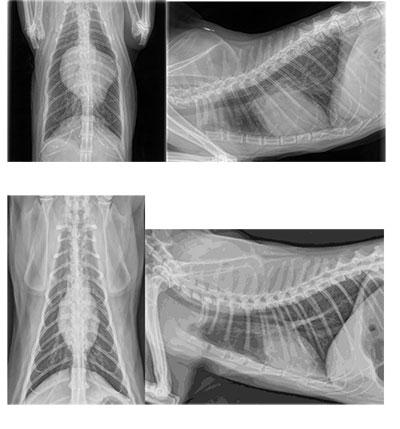
Heart Disease and Cats
Thursday, February 9, 2017
February is American Heart Month. We all know people can get heart disease but did you know that cats can get heart disease?
Cardiomyopathy is a disease of the myocardium or heart muscle. It can cause the heart to dilate or have poor pumping power. It can also cause the heart to become restrictive impairing the heart’s ability to fill or cause hypertrophy or a thickened heart.
The most common form of cardiomyopathy seen in cats is the hypertrophic form. This thickening of the heart muscle can lead to abnormal filling of the heart and decreased blood flow to the heart muscle.
Abnormal filling of the heart can lead to congestive heart failure, which can cause respiratory distress. If untreated, it can lead to death.
The abnormal filling can also cause the left atrium to dilate. The dilation, along with other factors, can lead to clots in the heart. These clots can dislodge and go to multiple areas of the body.
The most common place for clots to travel is to the distal aorta as it branches to the hind legs. Hind leg clots result in extreme pain and paralysis of the cat’s hind legs.
Abnormal blood flow to the heart can also lead to abnormal electrical activity of the heart, which can cause fainting and even sudden death.
Restrictive cardiomyopathy is caused by abnormal fibrous tissue that accumulates in the heart muscle. It is much less common than the hypertrophied form.
This condition leads to similar problems to that of the hypertrophied form such as congestive heart failure and clot formation.
Early suspicion of cardiomyopathy may be the presence of a heart murmur, a gallop or extra heart sound, or an arrhythmia or irregular heart rhythm. These can be detected with a stethoscope by your veterinarian during a routine physical examination.
Definitive diagnosis of feline cardiomyopathy and its potential adverse effects require additional testing.
Testing often includes routine blood work, thyroid level in older cats, blood pressure, electrocardiogram, and chest radiographs (x-rays) if signs of clots or congestive heart failure are present.
Testing to determine what form of cardiomyopathy is present requires the use of a cardiac ultrasound or echocardiogram.
Echocardiography measures the thickness of the heart, size of the left atrium and presence of clots in the left atrium. It can also measure contractile function of the heart and filling ability of the heart.
Advanced echocardiographic imaging is often needed. This requires expensive ultrasound equipment and advanced training to interpret the findings. Following veterinary college, board certified cardiologists are required to have three years of advanced training focusing on the diagnosis and management of cardiac disease in animals.
Treatment for feline cardiomyopathies is typically medical management with drugs. Drugs can be used to treat congestive heart failure, help prevent clot formation, improve heart filling, and suppress arrhythmias.
Currently there is no drug that will reverse the dilation, hypertrophy, or fibrous tissue that occurs with cardiomyopathies.
Here are some tips for keeping your cat heart healthy:
- Keep your cat at an ideal body weight. Obesity increases stress on the heart and has other negative health effects.
- Make sure your cat is stimulated to exercise daily. Spend time playing with your cat.
- Routine physical exam needs to be performed by your primary care veterinarian. If abnormities are seen, a consultation with a board certified veterinary cardiologist may benefit your pet.
by Ryan Baumwart, DVM, DACVIM (Cardiology)
Pictured above: The photo shows radiographs of an abnormal heart (top photos) and a normal feline heart (bottom photos).
Veterinary Viewpoints is provided by the faculty of the OSU Veterinary Medical Hospital. Dr. Ryan Baumwart is a board certified veterinary cardiologist on staff. Certified by the American Animal Hospital Association, the hospital is open to the public providing routine and specialized care for all species and 24-hour emergency care, 365 days a year.
